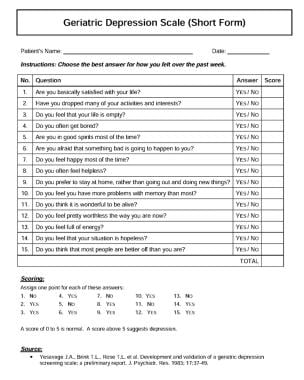Other screening tools have been used to screen for postpartum depression. Most mothers are not screened for this condition, and an ideal screening tool has not been identified. Postpartum depression is the most common complication of childbearing.

The 10-question Edinburgh Postnatal Depression Scale (EPDS) is a valuable and effici ent way of identifying patients at risk for “perinatal” depression. The purpose of this study was to develop a new, brief screening measure to identify postpartum distress, defined as symptoms of depression and anxiety. There are ways to help predict whether or not you are at risk of developing postpartum depression. It is important to recognize signs, symptoms and risk factors as soon as possible.
Women screening positive for symptoms of PPD should be further assessed by a health care provider to confirm whether or not clinical depression is present. The PHQ-is validated as a first-step screener for depression in adolescents and adults (to be followed by full PHQ-if the PHQ-is positive), but not for postpartum depression screening. Complete an interactive quiz and share the with your health care provider.

The Edinburgh Post Natal Depression Scale (EPDS) (J.L. Cox, J.M. Holden, R. Sagovsky, Department of Psychiatry, University of Edinburgh) Please note: The EPDS is only a screening tool.
When to screen for postpartum depression? Should you screen for postpartum depression? Are You at risk for post-partum depression? How do overcome postpartum depression? Research has shown that women with a history of stressful pregnancies, childbirths or previous postpartum depression run a higher risk of developing postpartum depression.
The following are questions that will assess your risk for developing postpartum depression based on your pregnancy history. These questions may not be applicable to everyone. ABSTRACT: Perinatal depression , which includes major and minor depressive episodes that occur during pregnancy or in the first months after delivery, is one of the most common medical complications during pregnancy and the postpartum perio affecting one in seven women. Find our postpartum depression support and resources available to ensure you and your loved ones understand the signs of PPD and know you are not alone. Screening for Perinatal Depression.
If you have postpartum depression , prompt treatment can help you manage your symptoms and help you bond with your baby. The evidence-based Agency for Healthcare Research and Quality (ARHQ) screening framework begins by identifying a cohort of postpartum women with unknown mood state, proceeds to formal postpartum screening , diagnostic evaluation for those with positive screens, and random group assignment with follow-up evaluation. This screening helps find out if you have postpartum depression , a condition that causes intense sadness and other symptoms lasting several weeks or longer after having a baby. There’s no blood test or body scan that shows you have this. SCREENING FOR PRENATAL AND POSTPARTUM DEPRESSION WISCONSIN ASSOCIATION for Perinatal Care Depression screening can improve health outcomes when combined with a system for treatment.
This WAPC position statement includes the rationale and plan for routine depression screening and treatment of pregnant and postpartum women by health care providers. In evaluating strategies involving screening for postpartum depression , patients, providers, and policymakers must consider the tradeoffs between the likely benefits and harms of screening. Although direct evidence from appropriately designed trials is ideal, such data are often lacking (and are lacking for screening for postpartum depression ). Patient completes PHQ-Quick Depression Assessment. To find postpartum depression screening tools for use by healthcare providers, please click this link.
It will take you outside of. The spectrum of postpartum mood disorders in-cludes the postpartum blues, postpartum depression , and postpartum psychosis, disorders that have a. Initially do the screening at the first prenatal visit. It is suggested that screening also be done at the first postpartum visit and the 4- to 6-week postpartum visit for breastfeeding and nonbreastfeeding women.

With postpartum depression , feelings of sadness and anxiety can be extreme and might interfere with a woman’s ability to care for herself or her family. Mothers with postpartum depression experience feelings of. At this time, no single screening tool is recommended by U. It covers the signs, symptoms and causes of postpartum depression , when to seek treatment from a health care provider and the use of. Preventive Services Task Force recommends screening pregnant and postpartum women for depression. Both two-step and one-step screening strategies are effective in identifying peripartum.
Previously, depression screening for all adults was done by a standalone PHQ-tool with additional depression questions on the back page. The Edinburgh Postnatal Depression Scale (EPDS) is a set of screening questions that can indicate whether a parent has symptoms that are common in women with depression and anxiety during pregnancy and in the year following the birth of a child.
No comments:
Post a Comment
Note: Only a member of this blog may post a comment.